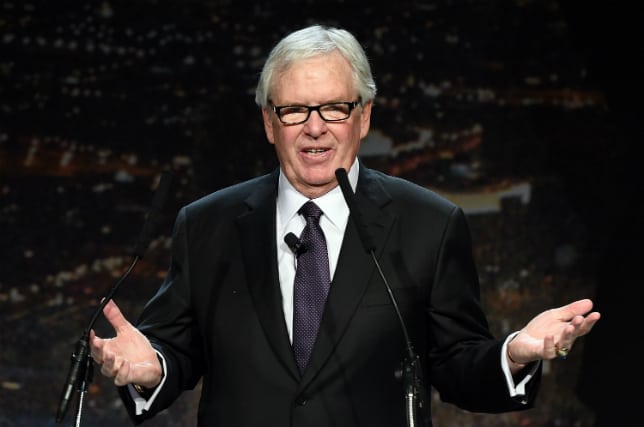
The salary cap era gives the Las Vegas franchise competitive advantages no expansion teams have experienced before.
 Why Las Vegas' expansion team should be sneaky-competitive in Season 1
Why Las Vegas' expansion team should be sneaky-competitive in Season 1Any smug prognosticator convinced Las Vegas’ NHL franchise will be a laughing stock has a head start. It’s an expansion team, after all, and recent NHL history tells us brand-new franchises normally fall flat on their faces.
The San Jose Sharks joined the NHL 25 years ago and won a combined 28 games in their first two seasons. The Ottawa Senators arrived a year later and won 24 games over their first two years. The Tampa Bay Lightning, Anaheim Ducks, Atlanta Thrashers, Columbus Blue Jackets, Minnesota Wild, Nashville Predators… each of those franchises wobbled out of the womb like a baby calf. The 1993-94 Florida Panthers set the gold standard of modern expansion club respectability, and even they didn’t finish .500, going 33-34-17. None of those teams made the post-season in its first two tries.
It thus stands to reason Vegas, a market already inviting some skepticism of its ability to fill an NHL arena long term, is in trouble. History suggests teams take years to build their youth crop and field competitive clubs. If the Vegas fan base is as fickle as some perceive it to be, that’s a deadly combination of lack of winning and lack of interest.
But Vegas has something going for it no franchise has before upon its inception: the salary cap. Vegas is the cap era’s first expansion team, and it will have advantages every other new NHL franchise has lacked.
When the expansion draft arrives next June, the other 30 NHL clubs will protect seven forwards, three defensemen and one goaltender or eight skaters and one goaltender. They’ll have to use a protection slot if they want to retain any players with continuing no-movement clauses at the time of the draft. They must expose at least one D-man and at least two forwards who (a) are under contract in 2017-18 and (b) played at least 40 games the prior season or 70 games over the prior two seasons.
Meanwhile, Vegas will choose a player from all 30 clubs, with a minimum of 14 forwards, nine defensemen and three goalies. That means it can build a 30-player base comprised entirely of NHL-caliber guys. How many existing NHL teams can do so? And that doesn’t include a potential high-ceiling first-round pick Vegas will get in the entry draft. Vegas will have the same odds as the team with the third-lowest point total in 2016-17, meaning Vegas picks no lower than sixth overall based on how the lottery can go.
Better yet, in the expansion draft, Vegas must select players with an aggregate value between 60 and 100 percent of the prior season’s upper limit for the salary cap. Apply that to the $73 million limit for 2016-17, and that means Vegas’ payroll will fall between $43.8 million and $73 million. Vegas thus doesn’t have to hit the league-wide salary floor of $54 million. But with a Scrooge McDuck-rich owner in Bill Foley who just dropped a record $500 million for the franchise, do we really expect Vegas to crawl around near the poverty line? Especially with so much pressure to prove the fans will support the team? Don’t be surprised if Foley gives the green light to take on significant salary. The team will have to wait several years for its first entry-draft classes to develop into a legitimate farm system anyway, so why not keep their seats warm with decent players, albeit expensive ones?
Here’s where the other 30 teams come in. The expansion draft will create the equivalent of compliance (a.k.a. free) buyouts for any high-priced players the teams choose not to protect. It wouldn’t be remotely surprising to see the Los Angeles Kings expose Dustin Brown, the Washington Capitals Brooks Orpik or the New York Rangers Dan Girardi. Doing so benefits the existing franchises, relieving them of albatross contracts, and it also helps Vegas meet its salary requirements. One of those players may weigh down an elite team, but if Vegas loads up on expensive veterans, it will end up with a feisty, competitive roster loaded with good leaders. A lame duck lineup in the long run? Sure. But a tough, savvy veteran group that could prey on young upstart opponents? Very possibly. We also know each existing franchise can only protect one goalie. With the position’s talent pool never better or deeper, we can bank on Vegas landing at least one quality stopper. Marc-Andre Fleury? Semyon Varlamov?
The NHL knows it has something to prove by taking a chance on a second desert market. That’s why it, pardon the pun, stacked the deck in Vegas’ favor. The expansion draft rules and salary cap will help Foley ice a surprisingly decent roster in the early years. That doesn’t guarantee long-term success. It’ll be up to whatever hockey brain trust he hires to accomplish that. But out of the gate, this newborn franchise won’t embarrass itself.
Matt Larkin is a writer and editor at The Hockey News and a regular contributor to the thn.com Post-To-Post blog. For more great profiles, news and views from the world of hockey, subscribe to The Hockey News magazine. Follow Matt Larkin on Twitter at @THNMattLarkin

